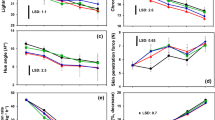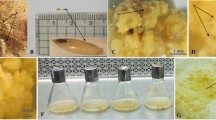Abstract
Cordyceps militaris is a highly valued edible and medicinal fungus due to its production of various metabolites, including adenosine, cordycepin, N6-(2-hydroxyethyl)-adenosine, and carotenoids. The contents of these metabolites are indicative of the quality of commercially available fruit body of this fungus. In this work, the effects of environmental abiotic factors, including heat and light stresses, on the fruit body growth and metabolite production in C. militaris were evaluated during the late growth stage. The optimal growth temperature of C. militaris was 20 °C. It was found that a heat stress of 25 °C for 5–20 days during the late growth stage significantly promoted cordycepin and carotenoid production without affecting the biological efficiency. Light stress at 6000 lx for 5–20 days during the late growth stage significantly promoted cordycepin production but decreased the carotenoid content. Both heat and light stresses promoted N6-(2-hydroxyethyl)-adenosine production. In addition, gene expression analysis showed that there were simultaneous increases in the expression of genes encoding a metal-dependent phosphohydrolase (CCM_04437) and ATP phosphoribosyltransferase (CCM_04438) that are involved in the cordycepin biosynthesis pathway, which was consistent with the accumulation of cordycepin during heat stress for 5–20 days. A positive weak correlation between the cordycepin and adenosine contents was observed with a Pearson correlation coefficient of 0.338 (P < 0.05). The results presented herein provide a new strategy for the production of a superior quality fruit body of C. militaris and contribute to further elucidation of the effects of abiotic stress on metabolite accumulation in fungi.





Similar content being viewed by others
References
Ahn YJ, Park SJ, Lee SG, Shin SC, Cho DH (2000) Cordycepin: selective growth inhibitor derived from liquid culture of Cordyceps militaris against Clostridium spp. J Agric Food Chem 48(7):2744–2748
Calvo AM, Wilson RA, Bok JW, Keller NP (2002) Relationship between secondary metabolism and fungal development. Microbiol Mol Biol Rev 66(3):447–459
Chai YQ, Wei ZM, Chen ZA, Li XL, Liu YG, Wang GE (2004) N6-(2-hydroxyethyl)-adenosine’ application in the preparation of analgesic drugs. China, ZL200410094511.0. (in Chinese)
Chang ST, Miles PG (2004) Mushrooms: cultivation, nutritional value, medicinal effect and environmental impact. CRC Press LLC 38(4):688–692
Chen C, Bau T, Bao HY (2013) Chemical composition analysis of cultured Cordyceps militaris. Food Sci 34(11):36–40 (in Chinese)
Chen AH, Wang YL, Shao Y, Huang B (2017) A novel technique for rejuvenation of degenerated caterpillar medicinal mushroom, Cordyceps militaris (Ascomycetes), a valued traditional Chinese medicine. Int J Med Mushrooms 19(1):87–91
Cunningham KG, Manson W, Spring FS, Hutchinson SA (1950) Cordycepin, a metabolic product from cultures of Cordyceps militaris (Linn.) Link. Nature 166(4231):949
Das SK, Masuda M, Hatashita M, Sakurai A, Sakakibara M (2008) A new approach for improving cordycepin productivity in surface liquid culture of Cordyceps militaris using high-energy ion beam irradiation. Lett Appl Microbiol 47(6):534–538
Das SK, Masuda M, Sakurai A, Sakakibara M (2010) Medicinal uses of the mushroom Cordyceps militaris: current state and prospects. Fitoterapia 81(8):961–968
Del Campo JA, Moreno J, Rodriguez H, Vargas MA, Rivas J, Guerrero MG (1999) Carotenoid content of chlorophycean microalgae: factors determining lutein accumulation in Muriellopsis sp. (Chlorophyta). J Biotechnol 76(1):51–59
Dong CH, Yao YJ (2011) On the reliability of fungal materials used in studies on Ophiocordyceps sinensis. J Ind Microbiol Biotechnol 38(8):1027–1035
Dong JZ, Wang SH, Ai XR, Yao L, Sun ZW, Lei C, Wang Y, Wang Q (2013) Composition and characterization of cordyxanthins from Cordyceps militaris fruit bodies. J Func Foods 5(3):1450–1455
Fang M, Chai YQ, Chen GJ, Wang HD, Huang B (2016) N6-(2-hydroxyethyl)-adenosine exhibits insecticidal activity against Plutella xylostella via adenosine receptors. PLoS One 11(9):e0162859
Fu MJ, Wang XJ (2005) Accumulation of carotenoid in Colletotrichum gloeosporioides induced by blue light. Acta Microbiol Sin 45(5):795–797
Furuya T, Hirotani M, Matsuzawa M (1983) N6-(2-hydroxyethyl)-adenosine, a biologically active compound from cultured mycelia of Cordyceps and Isaria species. Phytochemistry 22(11):2509–2512
Gomes CV, Kaster MP, Tomé AR, Agostinho PM, Cunha RA (2011) Adenosine receptors and brain diseases: neuroprotection and neurodegeneration. Biochim Biophys Acta 1808(5):1380–1399
Guo MM, Guo SP, Yang HJ, Bu N, Dong CH (2016) Comparison of major bioactive compounds of the caterpillar medicinal mushroom, Cordyceps militaris (Ascomycetes), fruiting bodies cultured on wheat substrate and pupae. Int J Med Mushrooms 18(4):327–336
Huang SJ, Lin CP, Mau JL, Li YS, Tsai SY (2015) Effect of UV-B irradiation on physiologically active substance content and antioxidant properties of the medicinal caterpillar fungus Cordyceps militaris (Ascomycetes). J Med Mushrooms 17(3):241–253
OncoVista Inc. (2008) A phase I/II study of cordycepin plus pentostatin in patients with refractory TdT-positive leukemia. Clinical Trials. https://clinicaltrials.gov/show/NCT00709215. Accessed 2 Jan 2018
Kang N, Lee HH, Park I, Seo YS (2017) Development of high cordycepin-producing Cordyceps militaris strains. Mycobiology 45(1):31–38
Kitakaze M, Hori M (2000) Adenosine therapy: a new approach to chronic heart failure. Expert Opin Investig Drugs 9(11):2519–2535
Kojima M, Kimura N, Miura R (2015) Regulation of primary metabolic pathways in oyster mushroom mycelia induced by blue light stimulation: accumulation of shikimic acid. Sci Rep 5:8630. https://doi.org/10.1038/srep08630
Kornerup A, Wanscher JH (1978) Methuen handbook of colour. EyreMethuen, London
Krupodorova TA, Barshteyn VY (2015) Alternative substrates for higher mushrooms mycelia cultivation. J Biosci Bioeng 4(3):339–347
Lee HH, Kang N, Park I, Park J, Kim I, Kim J, Kim N, Lee JY, Seo YS (2017) Characterization of newly bred Cordyceps militaris strains for higher production of cordycepin through HPLC and URP-PCR analysis. J Microbiol Biotechnol 27(7):1223–1232
Leonardi P, Iotti M, Zeppa SD, Lancellotti E, Amicucc A, Zambonelli A (2017) Morphological and functional changes in mycelium and mycorrhizas of Tuber borchii due to heat stress. Fungal Ecol 29:20–29
Li SP, Yang FQ, Tsim KW (2006) Quality control of Cordyceps sinensis, a valued traditional Chinese medicine. J Pharm Biomed Anal 41(5):1571–1584
Lian TT, Dong CH, Yang T, Sun JD (2014) Three types of geranylgeranyl diphosphate synthases from the medicinal caterpillar fungus, Cordyceps militaris (Ascomycetes). Int J Med Mushrooms 16(2):115–124
Lim LT, Lee CY, Chang ET (2012) Optimization of solid state culture conditions for the production of adenosine, cordycepin, and D-mannitol in fruiting bodies of medicinal caterpillar fungus Cordyceps militaris (L.:Fr.) Link (Ascomycetes). Int J Med Mushrooms 14(2):181–187
Lin S, Liu ZQ, Xue YP, Baker PJ, Wu H, Xu F, Teng Y, Brathwaite ME, Zheng YG (2016) Biosynthetic pathway analysis for improving the cordycepin and cordycepic acid production in Hirsutella sinensis. Appl Biochem Biotechnol 179(4):633–649
Livak KJ, Schmittgen TD (2001) Analysis of relative gene expression data using real-time quantitative PCR and 2-∆∆C(T) method. Methods 25:402–408
Lu ZL, Kong XX, Lu ZM, Xiao MX, Chen MY, Zhu L, Shen YM, Hu XY, Song SY (2014) Para-aminobenzoic acid (PABA) synthase enhances thermotolerance of mushroom Agaricus bisporus. PLoS One 9(3):e91298
Lu MY, Chen CC, Lee LY, Lin TW, Kuo CF (2015) N6-(2-hydroxyethyl)-adenosine in the medicinal mushroom Cordyceps cicadae attenuates lipopolysaccharide-stimulated pro-inflammatory responses by suppressing TLR4-mediated NF-kB signaling pathways. J Nat Prod 78(10):2452–2460
Mao XB, Zhong JJ (2004) Hyperproduction of cordycepin by two-stage dissolved oxygen control in submerged cultivation of medicinal mushroom Cordyceps militaris in bioreactors. Biotechnol Prog 20(5):1408–1413
Masuda M, Urabe E, Honda H, Sakurai A, Sakakibara M (2007) Enhanced production of cordycepin by surface culture using the medicinal mushroom Cordyceps militaris. Enzym Microb Technol 40:1199–1205
Milani A, Basirnejad M, Shahbazi S, Bolhassani A (2017) Carotenoids: biochemistry, pharmacology and treatment. Br J Pharmacol 174(11):1290–1324
Oh TJ, Hyun SH, Lee SG, Chun YJ, Sung GH, Choi HK (2014) NMR and GC-MS based metabolic profiling and free-radical scavenging activities of Cordyceps pruinosa mycelia cultivated under different media and light conditions. PLoS One 9(6):e90823
Razavi SH, Marc I (2006) Effect of temperature and pH on the growth kinetics and carotenoid production by Sporobolomyces ruberrimus H110 using technical glycerol as carbon source. Iran J Chem Chem Eng 23(3):59–64
Shrestha B, Han SK, Lee WH, Choi SK, Lee JO, Sung JM (2005a) Distribution and in vitro fruiting of Cordyceps militaris in Korea. Mycobiology 33(4):178–181
Shrestha B, Han SK, Yoon KS, Sung JM (2005b) Morphological characteristics of conidiogenesis in Cordyceps militaris. Mycobiology 33(2):69–76
Shrestha B, Han SK, Sung JM, Sung GH (2012a) Fruiting body formation of Cordyceps militaris from multi-ascospore isolates and their single ascospore progeny strains. Mycobiology 40(2):100–106
Shrestha B, Zhang WM, Zhang YJ, Liu XZ (2012b) The medicinal fungus Cordyceps militaris: research and development. Mycol Prog 11(3):599–614
Song C, Chen Q, Wu XL, Zhang JX, Huang CY (2014) Heat stress induces apoptotic-like cell death in two Pleurotus species. Curr Microbiol 69(5):611–616
Sung JM, Park YJ, Lee JO, Han SK, Lee WH, Choi SK, Shrestha B (2006) Selection of superior strains of Cordyceps militaris with enhanced fruiting body productivity. Mycobiology 34(3):131–137
Tuli HS, Sharma AK, Sandhu SS, Kashyap D (2013) Cordycepin: a bioactive metabolite with therapeutic potential. Life Sci 93(23):863–869
Wu CY, Liang ZC, Tseng CY, Hu SH (2016) Effects of illumination pattern during cultivation of fruiting body and bioactive compound production by the caterpillar medicinal mushroom, Cordyceps militaris (Ascomycetes). Int J Med Mushrooms 18(7):589–597
Xia YL, Luo FF, Shang YF, Chen PL, Lu YZ, Wang CS (2017) Fungal cordycepin biosynthesis is coupled with the production of the safeguard molecule pentostatin. Cell Chem Biol 24:1–11
Xiao JH, Chen DX, Liu JW, Liu ZL, Wan WH, Fang N, Xiao Y, Qi Y, Liang ZQ (2004) Optimization of submerged culture requirements for the production of mycelial growth and exopolysaccharide by Cordyceps jiangxiensis JXPJ 0109. J Appl Microbiol 96(5):1105–1116
Xie CY, Gu ZX, Fan GJ, Gu FR, Han YB, Chen ZG (2009) Production of cordycepin and mycelia by submerged fermentation of Cordyceps militaris in mixture natural culture. Appl Biochem Biotechnol 158(2):483–492
Xu CP, Kim SW, Hwang HJ, Choi JW, Yun JW (2003) Optimization of submerged culture conditions for mycelia growth and exo-biopolymer production by Paecilomyces tenuipes C240. Process Biochem 38(7):1025–1030
Yan XT, Bao HY, Bau T (2010) Isolation and identification of one natural pigment from cultured Cordyceps militaris. Mycosystema 29(5):777–781
Yang T, Dong CH (2014) Photo morphogenesis and photo response of the blue-light receptor gene Cmwc-1 in different strains of Cordyceps militaris. FEMS Microbiol Lett 352(2):190–197
Yang T, Sun JD, Lian TT, Wang WZ, Dong CH (2014) Process optimization for extraction of carotenoids from medicinal caterpillar fungus, Cordyceps militaris. Int J Med Mushrooms 16(2):125–135
Yang T, Guo MM, Yang HJ, Guo SP, Dong CH (2016) The blue-light receptor CmWC-1 mediates fruit body development and secondary metabolism in Cordyceps militaris. Appl Microbiol Biotechnol 100(2):743–755
Yu L, Zhao J, Li SP, Fan H, Hong M, Wang YT, Zhu Q (2006) Quality evaluation of Cordyceps through simultaneous determination of eleven nucleosides and bases by RP-HPLC. J Sep Sci 29(7):953–958
Zhang W, Tang YJ (2008) A novel three-stage light irradiation strategy in the submerged fermentation of medicinal mushroom Ganoderma lucidum for the efficient production of ganoderic acid and Ganoderma polysaccharides. Biotechnol Prog 24(6):1249–1261
Zhang X, Ren A, Li MJ, Cao PF, Chen TX, Zhang G, Shi L, Jang AL, Zhao MW (2016) Heat stress modulates mycelium growth, heat shock protein expression, ganoderic acid biosynthesis and hyphal branching of Ganoderma lucidum via cytosolic Ca2+. Appl Environ Microbiol 82(14):4112–4125
Zheng P, Xia YL, Xiao GH, Xiong CH, Hu X, Zhang SW, Zheng HJ, Huang Y, Zhou Y, Wang SY, Zhao GP, Liu XZ, Leger R, Wang CS (2011) Genome sequence of the insect pathogenic fungus Cordyceps militaris, a valued traditional Chinese medicine. Genome Biol 12:R116
Funding
This study was funded by the National Natural Science Foundation of China (31572179, 31600054), the Coal-based Key Scientific and Technological Project from Shanxi Province (FT2014-03-01), and the Key Research and Development Program from Guangxi Province (2016AB05317).
Author information
Authors and Affiliations
Corresponding authors
Ethics declarations
Conflict of interest
The authors declare that they have no conflict of interest.
Ethical approval
This article does not contain any studies with human participants or animals performed by any of the authors.
Electronic supplementary material
ESM 1
(PDF 171 kb)
Rights and permissions
About this article
Cite this article
Jiaojiao, Z., Fen, W., Kuanbo, L. et al. Heat and light stresses affect metabolite production in the fruit body of the medicinal mushroom Cordyceps militaris. Appl Microbiol Biotechnol 102, 4523–4533 (2018). https://doi.org/10.1007/s00253-018-8899-3
Received:
Revised:
Accepted:
Published:
Issue Date:
DOI: https://doi.org/10.1007/s00253-018-8899-3




